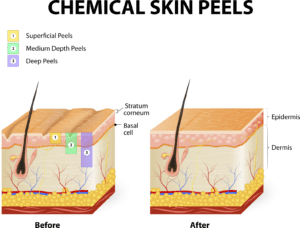It seems like chemical peels have been around since the beginning of time. Ancient Egyptians used animal oils, salt and alabaster to aesthetically improve skin and treat skin conditions. Egyptian women also took “sour milk” baths so their skin would be silky smooth (unknowingly they were essentially using lactic acid [an alpha-hydroxy acid] to treat their skin). Plasters containing mustard, sulfur and limestones were often used historically to tend to skin. Long ago Turks used fire to singe their skin so they would get “light exfoliation”. Indian women mixed urine with pumice for skin application so that their face would be soft and silky. Dermatologists first pioneered skin peeling for therapeutic benefit in about 1882 and early peeling agents included salicylic acid, resorcinol, phenol and trichloroacetic acid. Dr. G.M. Mackee, a British dermatologist, started to use phenol peels for acne scarring in about 1903 and he published those results in 1952.
So, why is all of this significant? For starters, it is obvious that humans have been preoccupied with youth and physical appearance since the beginning of time! Second, at some point in our lives, almost every man or woman is concerned about the quality of his or her skin. To this end, chemical peels can help! Chemical peels can improve overall skin quality, texture and appearance.
Chemical peels work by making use of the wound-healing activity that takes place when the skin is damaged. Application of a chemical peel induces controlled skin injury through the use of a caustic substance applied to skin. They are one of the most common facial resurfacing procedures and have many advantages; the procedure is usually quick, they are low cost and they have lots of flexibility.
Dermatologists have been using peeling agents for over 80 years! In the course of time, there have been many formulas and agents used for peeling of the skin. The selection of the type of peeling agent or the application technique depends upon an understanding of the depth of the peel (which really means the deepness of the “wound” the peel creates). Peel depths are usually considered light (superficial), medium-depth or deep. The possibility of wounding the skin increases as the depth of the peel increases.
If you are a patient with minimal sun damage and some freckles, you would want to use a milder peeling agent, so you are not unnecessarily damaging the skin. Sometimes varying strengths of chemical peels are used in combination on different areas of the face. As a general rule:
- light peels correct mild skin problems (skin dullness, hyperpigmentation and rough texture)
- medium-depth peels treat moderate skin issues (slight wrinkling and mild scarring)
- deep peels tend to more severe skin problems (deeper wrinkles and severe acne scarring)

Peels can treat sun damage (actinic damage), photo aging, hyperpigmentation, melasma, acne vulgaris and striae. Chemical peels can also be combined with other treatments like lasers and surgical procedures, i.e., a facelift. Light peels are wonderful at “freshening” the skin and improve the overall quality of skin without altering skin’s structure. The types of agents used for light or superficial peels include: trichloroacetic acid (TCA), Jessner’s solution, salicylic acid and glycolic acid.

Chemical peels do not really change pore size and they cannot improve sagging skin. Wrinkles may not improve if they are deep and combined with skin laxity that really needs a facelift. Sometimes acne scarring or wrinkles are too deep for a chemical peel. For these cases lasers, dermabrasion, subcision and injectable fillers may be more appropriate. A chemical peel may not completely resolve hyperpigmentation and caution needs to be used when peeling darker skin types. Last, chemical peels cannot remove broken blood vessels or redness from the face.
Aftercare for superficial peels include cleansing with a gentle cleanser and moisturizing as needed. A sunscreen with a minimum SPF 30 should be used each morning and applied every two hours when outside. Sun exposure should be avoided. Don’t forget…consistent sunscreen use after chemical peels will help maintain the benefit of the peel! Avoid drying or irritating medications, i.e., benzoyl peroxide or tretinoin for about 5-7 days after the peel. Do not peel, pull or scratch the treated areas–allow the areas to peel naturally. You may use a washcloth with light pressure to help with exfoliation.
